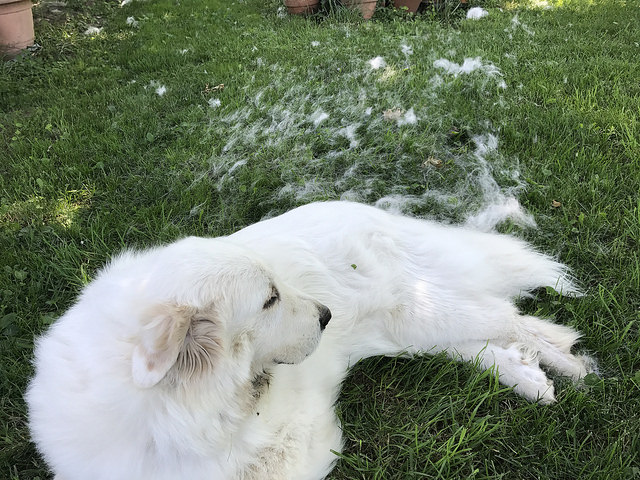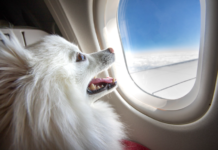Last Updated on September 3, 2023 by Fumipets
Managing the Dog Blowing Coat: Tips and Insights
Dog Blowing Coat offers insights into a common and often misunderstood phenomenon in a dog’s life. Dogs periodically shed their old fur, a process known as “blowing coat,” which can vary in intensity depending on the breed and season.
This summary delves into the reasons behind blowing coat, how to manage it, and what pet owners can do to ensure their furry friends remain comfortable and healthy during this natural phase.
Dog Blowing Coat
Although the phrase “dog blowing coat” isn’t well known, it’s an accurate depiction of all the enormous clumps of hair that your companion releases and sends flying on the wind, adhering to anything in their path.
Although every dog sheds, at least a little, not every dog blow coats. This is influenced by a wide range of variables, including species, heredity, health, and even hormones. The distinction between fur and hair is primarily to blame.
Keratin, a protein also present in skin and nails, is a component of both fur and hair, which develop within the same pore. Finer, shorter, and more closely clustered together are the fur filaments. Hair “grows beyond the length of fur, forming a protective layer of warmth and water resistance over the pet” and is longer, denser, and less compact than fur.
In contrast, other dogs have a double layer of fur and hair and must remove deceased cells to make room for new development. Therefore, a long-haired dog most likely has a single coat. It’s probably billowing coat season when you touch your adorable canine and discover your palm has significantly more fur than usual. This can happen in both the spring and autumn for some dogs.
Having to deal with a lot of hair at once can be daunting at first. Fortunately, there is a brief window for canine hair blow, and we have advice to help you deal with all that fuzz.
What Does Dog Blowing Coat Mean?
Dog types with two coats are frequently poofy or puffy canines. A silky undercoat and an exterior coat with “guard hair” make up their two-layered coverings.
The hair serves as protection, keeping the canine comfortable all year round. The top layer permits cold air to flow close to the dog’s skin after the hair has been removed.
There are four phases of fur and hair growth in dogs (well, and cats too!):
Anagen: active growth
Catagen: hair is fully grown
Telogen: hair is not only fully grown, but also fully attached to the animal and dormant
Exogen: Dormant hair falls out and anagen hair growth starts again
Excessive shedding happens during the exogen phase, when seasonal changes require double-coated dogs to adapt to temperature and comfort.

How Often Do Double-Coated Dogs Blow Their Coat?
Although it may not seem like it, most canines today live in more regulated settings than their forebears, which results in less shedding. However, the time of day and the weather determine when a dog’s hair blast is most likely to occur.
Hormonal changes, which are influenced by variations in lighting, govern shedding. The winter garment dissipates in the spring to make room for the summer coat, which is lightweight. Many cats and canines lose their summer fur as the days grow fewer so that a denser, bulkier hair can develop for the winter. Additionally, there will be a lot more hair shedding in the spring because the winter coat is so much denser.
The overcoat removes once a year, and the dense undercoat typically loses twice as much. Depending on the species, anticipate having mounds of fur for about 2-4 weeks each season.
For healthy, double-coated canines, billowing hair is typically normal, but if you feel there is an overwhelming quantity, or you observe skin irritations or behavioral changes, talk to your veterinary right away.
Double-Coated Dog Breeds That Blow Coat Each Year
Ah, this is where some types just go all out! Blowing hair is a natural occurrence for some Nordic puppies, such as the Siberian Husky, and occurs at least twice a year.
Samoyeds are equipped with a wooly layer and a lengthy, thick exterior hair that were specifically developed to endure harsh and subfreezing conditions. This species constantly sheds, but it does so more heavily once or twice a year during the shedding season.
Another type with a double covering is the enormous European Leonberger. Because of its short, fluffy undercoat and dense, complete exterior coat, Klein claims that the blasts hair twice a year. There is also a reputation for this species to discharge a lot. each day. Therefore, there will be a lot of cleaning and sweeping. each day!
However, the garment is the most important factor, not girth. One of the Pomeranian’s most distinctive characteristics is the thick double hair. To keep the gorgeous garment that we adore looking beautiful, frequent cleaning is required.

How to Deal With Shedding Season
With the proper equipment and a cleaning regimen, you’ll quickly perfect the art of flaking.
Know the maintenance needs for your species thoroughly first. An outline of a strategy for washing, combing, and other techniques for taming the fur can be provided by your veterinarian or a qualified groomer. For a while, you might need to scrub your dog twice daily just to keep up with everything.
Yes, for a few weeks, you’ll have to work extra hard to keep your canine friend’s mattress clean because it attracts more hair than anything else. the cooking table, as well as any other location where drifting debris might settle.
There are other sleek items that make cleaning up after him a little bit simpler, though a straightforward lint brush can work miracles for eliminating canine fur from many surfaces (including your pet!).
Just store your fine clothes—especially your black ones—away for a while. It makes no sense to attempt desperately to remove all of your hair!
Conclusion
A double-coated canine should never have its hair shaved to stop it from flying.
Many people mistakenly believe that grooming their double-coated type will keep them cooler, but in reality, it can have the reverse effect and even higher risks. A double-coated breed’s hair structure and pigment will gradually alter as a result of shaving. Additionally, it takes away the ability to warm the canine and provide solar protection.
Questions & Answers:
What exactly does it mean when a dog is “blowing coat”?
“Blowing coat” refers to the process in which a dog sheds its old or damaged fur to make way for a new, healthier coat. This shedding can be quite dramatic, depending on the breed.
What triggers a dog to go through the blowing coat phase, and how often does it occur?
Dogs typically blow their coat in response to seasonal changes. Breeds with double coats, like Huskies or Golden Retrievers, may do so more noticeably. It usually occurs twice a year, as they transition between winter and summer coats.
How can pet owners help their dogs during the blowing coat phase?
Regular grooming is essential during this phase to remove loose fur and prevent matting. Brushing your dog’s coat frequently not only reduces shedding around the house but also keeps your pet comfortable.
Are there specific dietary considerations that can help dogs during the blowing coat phase?
Ensuring your dog receives a balanced diet rich in essential nutrients can promote a healthy coat. Omega-3 fatty acids, often found in fish oil supplements, can help improve coat quality and reduce shedding.
When should pet owners be concerned about excessive shedding or coat problems during blowing coats, and what can they do if they suspect an issue?
While some shedding is normal during the blowing coat phase, excessive or sudden hair loss may be a sign of underlying health issues. If you notice bald patches, skin irritation, or other concerning symptoms, consult your veterinarian for a thorough examination and guidance on potential causes and treatments.


















